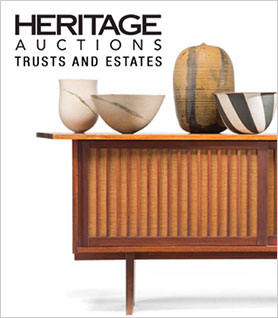Media Relations
Press Release - July 21, 2025
$10.3 Million Heritage Summer FUN U.S. Coins Auction
| 1860 Mormon Gold Half Eagle, 1915-S Panama-Pacific 50 Dollar Round and record-setting 1867 quarter eagle among event’s top highlights DOWNLOAD DIGITAL PRESS KIT This magnificent coin is remarkable in part because it is made from gold that was sourced in Colorado, where the element’s discovery prompted production of this coin by the Mormon community in Salt Lake City. This coin is from a likely mintage of just 587 pieces. The final result was the most ever realized for a K-6 Mormon five in any AU grade, and among the top five prices for any example of the variety. “It was originally believed to have been first coined in May 1859,” says Todd Imhof, Executive Vice President at Heritage Auctions, “but as it turns out, this is an impressive example of the rare lion and beehive issue that was struck in the first quarter of 1860, with an exceedingly small original production run.” A 1915-S Panama-Pacific 50 Dollar Round MS64 NGC. CAC ended at $138,000. This extraordinary coin was issued in conjunction with the Panama-Pacific International Exposition in San Francisco, an event that celebrated the opening of the Panama Canal in 1914 and the recovery of San Francisco from the 1906 earthquake and fire. The design by sculptor Robert Ingersoll Aitken — with the Roman goddess Minerva on the obverse and an owl perched on a pine branch, reinforcing Minerva’s symbolic role as a guardian of wisdom on the reverse — appears on both round and octagonal fifty dollar pieces. Initial sales of the coin lagged, despite the historical significance and artistic ambition behind the series, resulting in the sale of just 483 of the authorized 1,500 round examples, making the variant the less-distributed issue in the classic commemorative series. A 1913 Saint-Gaudens Double Eagle, MS65 PCGS. CAC brought $90,000. Rarely seen with CAC designation, the coin was scarce in the 1920s and 1930s before getting some traction in the 1940s. The 1913 is now a coveted rarity in MS65 and among the more challenging acquisitions at this grade level for even the most advanced collectors. Just six of the 36 Gem examples that previously passed through Heritage received CAC endorsements, and of that half dozen, just two have appeared in Heritage auctions within the past decade. Coming in at $87,000 was an 1851 Humbert Fifty Dollar, Reeded Edge, 887 Thous. MS60 NGC. K-7, R.5. The K-7 fifty is rare and desirable in all grades, but particularly so in Mint State condition. This K-7 fifty dollar gold piece features Albert Kuner’s new reverse die paired with the late die state 887 Thous obverse, with extensive die rust and light abrasions visible in the fields. This example is one of just two carrying a grade of 60; there are only 23 with higher grades. Three coins drew winning bids of $78,000: • An 1855 $50 Wass Molitor Fifty Dollar XF40 NGC. K-9, R.5 that was produced when Wass, Molitor & Co. responded to the San Francisco Mint’s inability to keep up with the demand for gold coinage in 1855. These large coins were struck to the federal standard of .900 pure gold and, unlike federal coinage that was alloyed with copper, the Wass, Molitor pieces were alloyed with California silver, a composition that resulted in private coinage of higher intrinsic value than the federal coinage. About 75 pieces survive of this scarce private gold piece, the final circulating fifty dollar denomination coin until the 1915 Panama-Pacific fifty dollar gold pieces. • A 1795 Capped Bust 13 Leaves Right Eagle, AU55 NGC — after the Philadelphia Mint began circulating gold coins in 1795 with an early mintage of half eagles, its focus turned to eagles, including an initial batch of 1,097, likely of the BD-1 variety. A total of 5,583 Capped Bust Right eagles were struck in late 1795 — some of which may have been struck early in 1796, as well. The surviving BD-1 population has been estimated at 225-325 in all grades. Another coin that fared exceedingly well was an 1822/1 Half Dollar O-101, R.1, MS65+ PCGS. CAC that reached $69,000. One of the top three pieces on the Condition Census and the most spectacularly toned example of this so-called “overdate” variety, only the former Eliasberg O-101 approaches this beauty’s eye appeal. Another impressive result was $55,200 for an 1886 Seven-Piece Proof Set, PR65 to PR67+ Cameo PCGS. CAC. Each of the coins in the set is CAC-approved. The set includes a Cent — Type One — PR66 Red and Brown, a Three Cent Nickel PR65. JD-1, R.1, a Nickel PR66+. JD-1, R.1, a Dime PR66. Fortin-Unlisted, a Quarter PR67+ Cameo. Briggs 2-B, a Half Dollar PR67. WB-101, Normal Date and a Silver Dollar PR67+. Complete results can be found at HA.com/1384. Heritage Auctions is the largest fine art and collectibles auction house founded in the United States, and the world's largest collectibles auctioneer. Heritage maintains offices in New York, Dallas, Beverly Hills, Chicago, Palm Beach, London, Paris, Amsterdam, Brussels, Hong Kong and Tokyo. Heritage also enjoys the highest Online traffic and dollar volume of any auction house on earth (source: SimilarWeb and Hiscox Report). The Internet's most popular auction-house website, HA.com, has more than 2 million registered bidder-members and searchable free archives of 7,000,000 past auction records with prices realized, descriptions and enlargeable photos. Reproduction rights routinely granted to media for photo credit. For breaking stories, follow us: HA.com/Facebook and HA.com/Twitter . Link to this release or view prior press releases . Hi-Res images available: Steve Lansdale, Public Relations Specialist 214-409-1699 or SteveL@HA.com |


